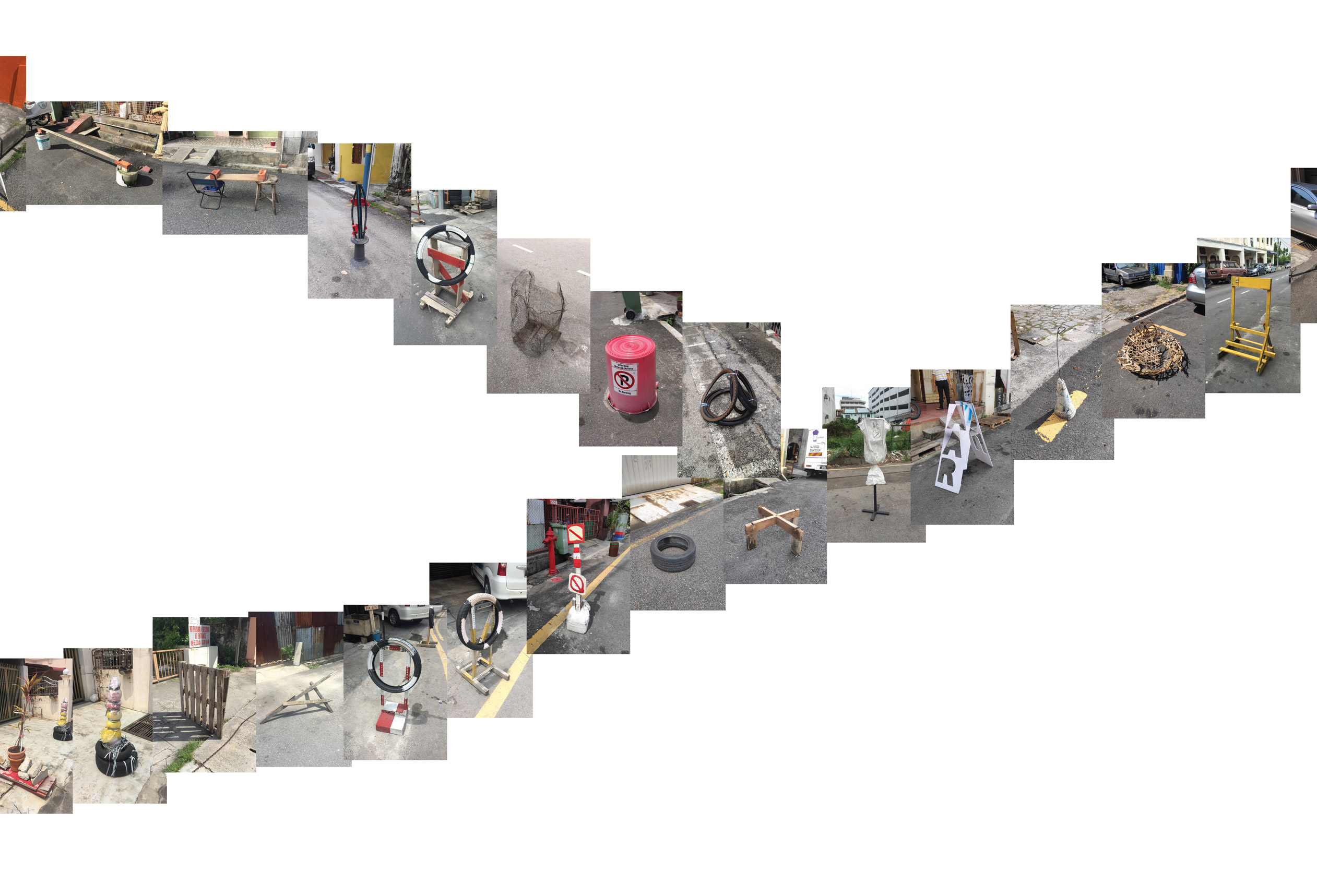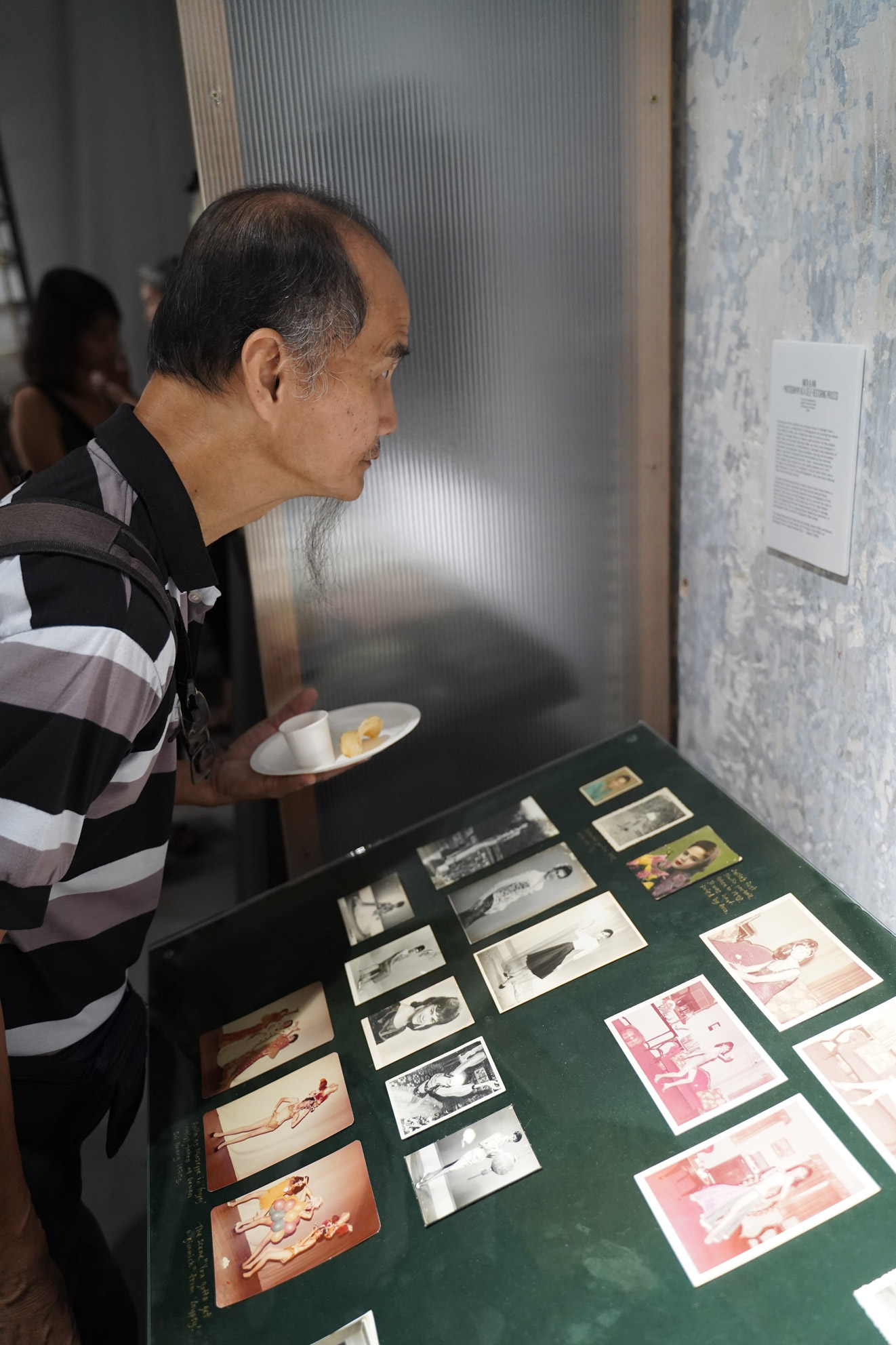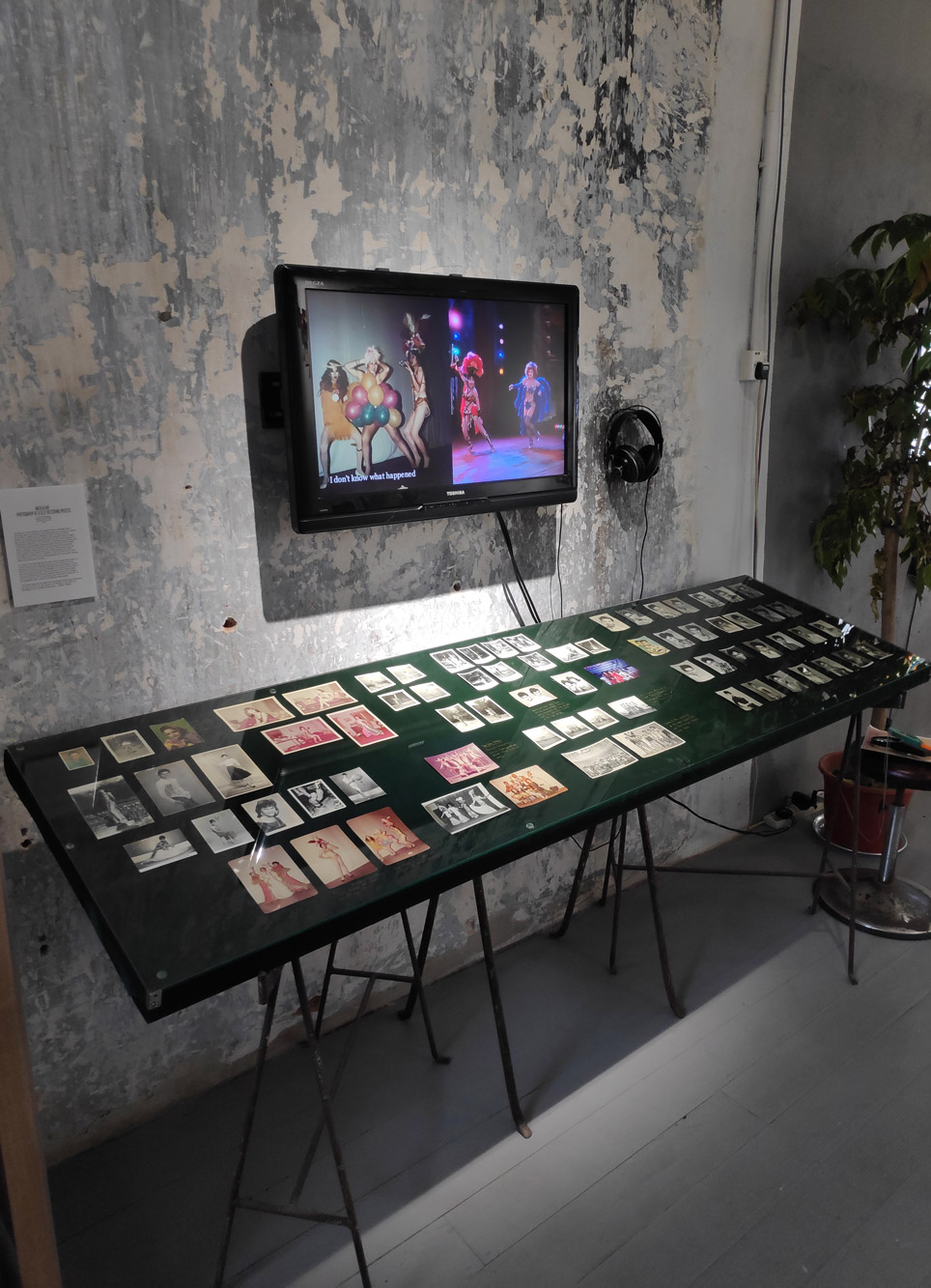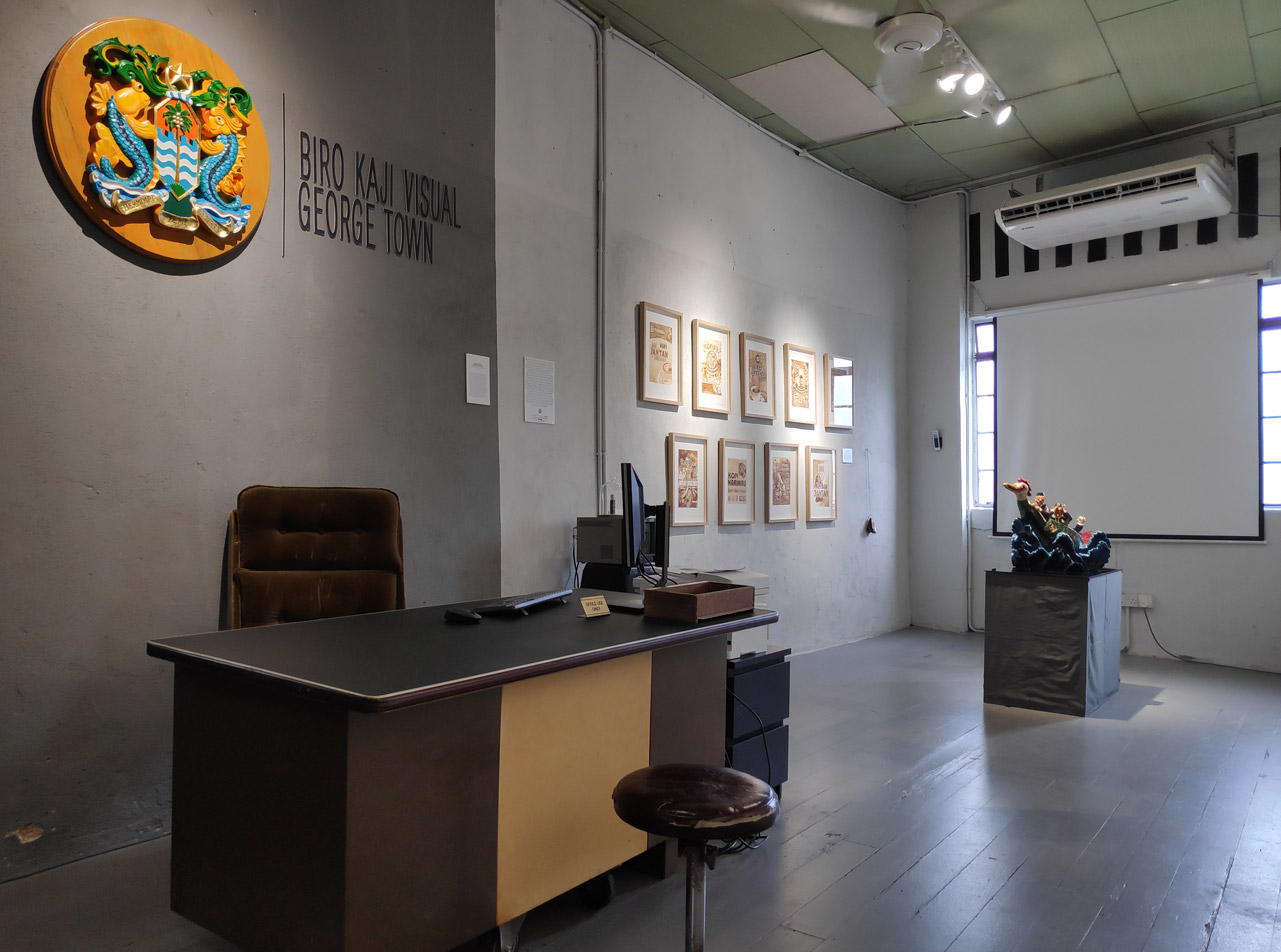Hoo Fan Chon is a visual arts practitioner based in George Town, Penang. His research-driven projects are often set in local geographies and concern class aspiration, cultural identity, informal histories, and colonial legacy.
︎ email ︎ cv
✺ 2025 ✺ 2024 ✺ 2023 ✺ 2022 ✺ 2021 ✺ 2020 ✺ 2019 ✺ 2018 ✺ older works ✺ photography ✺ video ✺ painting ✺ sculpture ✺ installation ✺ writing ✺ george town ✺ archive ✺ fish ✺ durian ✺ badminton ✺
︎ email ︎ cv
✺ 2025 ✺ 2024 ✺ 2023 ✺ 2022 ✺ 2021 ✺ 2020 ✺ 2019 ✺ 2018 ✺ older works ✺ photography ✺ video ✺ painting ✺ sculpture ✺ installation ✺ writing ✺ george town ✺ archive ✺ fish ✺ durian ✺ badminton ✺
Biro Kaji Visual George Town































Biro Kaji Visual George Town
2019 Nov, Narrow Marrow (George Town MY)
This exhibition was co-produced by Jamie Oon, in collaboration with The Back Room KL and hosted by Narrow Marrow.
Exhibition visual collaterals by Tauras Stalnionis.
Exhibition opening photos by Lo Shih-Tung
List of works:
Bermimpi Demi Negara (To Dream for One’s Country)
Relief wood carving: painted in acrylic & partially gilded in gold leaf, 72.8 x 72.8 x 7.8 cm, 2019
Silkscreen print, edition of 50 + 2 AP, 42 x 59.4 cm, acid-free 300gsm watercolour paper, 2019
Kopi Jantan series
A set of coffee paintings, instant coffee with gum arabic on A3 acid-free 300gsm watercolour paper, 2019
You chup, I snap (Temporary Parking Sculptures series)
In-situ photo collage, approx. 440 x 210 cm, 2019 - ongoing
Anita & Ava – Photography as a self-restoring process
Mix-media installation (found photographs, single-channel video), 2019 - ongoing
Riding the waves in search of the great bird 駕浪尋鵬
Woodcarving, painted in acrylic & partially gilded in gold leaf, approx. 70 x 55 x 50 cm, 2019
Karma Karma Chameleons
Set of 12 Ilford Gallerie metallic gloss photographic print, 11.9 x 17.4 cm each, 2019
Download BKVGT zine here.
2019 Nov, Narrow Marrow (George Town MY)
This exhibition was co-produced by Jamie Oon, in collaboration with The Back Room KL and hosted by Narrow Marrow.
Exhibition visual collaterals by Tauras Stalnionis.
Exhibition opening photos by Lo Shih-Tung
︎
List of works:
Bermimpi Demi Negara (To Dream for One’s Country)
Relief wood carving: painted in acrylic & partially gilded in gold leaf, 72.8 x 72.8 x 7.8 cm, 2019
Silkscreen print, edition of 50 + 2 AP, 42 x 59.4 cm, acid-free 300gsm watercolour paper, 2019
Kopi Jantan series
A set of coffee paintings, instant coffee with gum arabic on A3 acid-free 300gsm watercolour paper, 2019
You chup, I snap (Temporary Parking Sculptures series)
In-situ photo collage, approx. 440 x 210 cm, 2019 - ongoing
Anita & Ava – Photography as a self-restoring process
Mix-media installation (found photographs, single-channel video), 2019 - ongoing
Riding the waves in search of the great bird 駕浪尋鵬
Woodcarving, painted in acrylic & partially gilded in gold leaf, approx. 70 x 55 x 50 cm, 2019
Karma Karma Chameleons
Set of 12 Ilford Gallerie metallic gloss photographic print, 11.9 x 17.4 cm each, 2019
︎
Download BKVGT zine here.
Hoo Fan Chon brings into play his intimate knowledge of George Town to examine its diverse visual culture in Biro Kaji Visual George Town. He shows that George Town is more than just a spectacular remnant of colonial history. He attends to quotidian but obscure visual phenomena which shape the city and the lives of its inhabitants. He draws our attention to the interrelation between individuals, communities and belief systems which are embedded in the configuration of objects, images, visual traditions and practices.
Hoo is more than a modern-day flaneur. He brings inconspicuous visual phenomena and histories of George Town to the fore not only by observing the people who inhabit the city, but also the objects and images which populate it. He makes mute objects and images speak using two approaches. On the one hand, he traces the lives of remarkable individuals and communities through a study of visual materials which he chanced upon in the city. On the other hand, he identifies visual traditions and practices which are ubiquitous, but paradoxically obscure, and analyses their visual logic.
In 1786, the British East India Company established control over Penang. Colonial authorities established a Committee of Assessors to supervise urban development in 1801 and established the George Town Municipal Commission in 1857. Bureaus serve the purposes of the state. Hoo turns the workings of a bureau inside out by reimagining it as an entity which serves pedagogic and communal purposes. His bureau helps communities to better understand each other, their city and its sociohistorical contexts. However, he doesn’t just reimagine the bureau as a metaphor. He performs the workings of a bureau by laboriously observing, identifying, searching, studying, analysing and sensitively reinterpreting visual materials which are scattered around George Town.
The present-day coat of arms of the Penang Island City Council, which has been in use since 1974, when the George Town City Council merged with the Penang Rural District Council to form the Penang Island Municipal Council, is an amalgamation of local and colonial visual and idiomatic expressions. The bulk of the imagery is local apart from the exotic elements of dolphins and acanthus leaves, which are recurring motifs in Western art. Hoo refashions the coat of arms by superimposing details which he draws from local cultural sources on exotic ones. He also replaces the motto Memimpin Sambil Berkhidmat with Bermimpi Demi Negara. He does not reject inherited pictorial features, and the colonial history that is associated with them. Instead, he amends the coat of arms in a way which recognises George Town’s complex history. A tropical pitcher plant coexists with the acanthus. A mudskipper and a dolphin flank the coat of arms on each side respectively.
Kopi Jantan is a drink which is sold at mamak stalls for men looking for an accessible and cheap alternative for sexual stimulation. Some of the main ingredients of the drink are instant coffee and tongkat ali, a medicinal plant which has been used as a traditional herbal remedy in Malay healing practices for centuries. The claim that it is a natural concoction of plant-based ingredients is dubious as some if not most brands contain traces of synthetic drugs. Traditional healers used to be involved in many important aspects of the communities they served. While this is no longer the case in urban environments, traditional healing culture still occupies a significant but discreet place in our modern-day society.
In Kopi Jantan series, Hoo samples different brands of instant coffee with aphrodisiac property to examine their packaging designs, which comprise various configurations of pictorial details such as coffee beans, animals, human figures and herbal ingredients. He transfers and enlarges the packaging designs using instant coffee pigment onto paper to create paintings in sepia tone. The paintings encourage us to think about how gendered desires are visualized. In other words, his process of replicating and enlarging the images foregrounds the desires which are embedded in the visual vocabulary of the packaging. It is analogous to the process of treating a photographic film to transform a latent image into a visible one.
Hoo stumbled upon photographs depicting individuals, in particular Anita and Ava who were part of a tight-knit queer community in George Town during the latter half of the twentieth century. Anita and Ava had known each other since they were teenagers. He animates the private and public lives of these remarkable individuals through a series of interviews and meetings with Anita, who survived Ava. Anita & Ava is an oral history project which wouldn’t have been possible without the discovery of the photographs.
By sharing Anita and Ava’s stories, Hoo expands public imagination about the various kinds of lives which people once had, continue to have, and could have in George Town today. The photographs chart the individual and collective lives of Anita and Ava, their transition from boyhood to womanhood, and their friendship with each other and with people in their community. Anita and Ava were fashioning their own world, but they were not living insular existences. They performed for a living and crossed paths with royal, state and public figures who patronized their performances.
Riding the waves in search of the great bird 駕浪尋鵬 is a sculpture which commemorates Ibrahim Mat Zin, a.k.a. Raja Bomoh, and his assistants who performed a shamanic ritual to locate the missing airplane MH370. The media sensationalised and ridiculed the ritual. Ibrahim was arrested and sent to the Dang Wangi and Jinjang lockup. The Syariah Court charged him for insulting Islam. Hoo brings to light the widening rift between modern thinking and folk beliefs. He memorializes the ritual by turning the event into a statue after the fashion of a restored antique sculpture. He meticulously chiselled the sculpture out of wood, which he learnt from a master carver in the city. In this work, Hoo alludes to the Chinese religious practice of worshipping the deity Datuk Gong for prosperity and security. He also turns the ritual into a Chinese proverb, which is expressed in the title of the work, 駕浪尋鵬.
Karma Karma Chameleons consists of photographs of female nightclub entertainers. Hoo suspects that the entertainers were handing out these photographs to advertise their services. The photos were mostly taken in photo studios in KL. They are fantastical. They feature women posing in glamorous bodysuits and dresses with feathers, sequins and ruffles. The colour photographs faded and details blurred into the background when Hoo discovered them in George Town. He brought the photographs back to life by digitally enhancing their colours. However, he was concerned that the women might not like to be seen in this light if they were alive today. He partially obscured their eyes so that they could see the audience, but the audience would not be able to reciprocate their gaze.
UNESCO designated Melaka and George Town, the historic cities of the Straits of Malacca, as World Heritage Sites in 2008. Since then, tourists have flocked to George Town in droves, which in turn increased foot and vehicular traffic and exacerbated the problem of limited parking space in the city. Hoo documents local inhabitants’ ingenious ways of responding to this problem in You chup, I snap, which comprises photographs of makeshift parking sculptures of varying complexity. Local inhabitants created the fragmentary sculptures using materials such as strings, plastic poles, buckets, broken stools, wooden planks, artificial plants, brick and concrete. They appear to have carefully considered function, form, beauty and proportion when making the parking sculptures.
Biro Kaji Visual George Town provides important insights into a fascinating range of visual practices and traditions which have shaped George Town and the lives of its inhabitants. Hoo shares his intimate knowledge of his adopted city generously. He demonstrates how individuals and communities in George Town have always fashioned and negotiated their identities and desires in creative ways. Biro Kaji Visual George Town encourages us to remain ever curious and observant of our surroundings. The humdrum of life sometimes blinds us from seeing and appreciating the inconspicuous charms of our locality. Hoo shows us that in the case of George Town, there is more to the city than meets the eye.
Text by Eric Goh (from BKVGT zine)
Hoo is more than a modern-day flaneur. He brings inconspicuous visual phenomena and histories of George Town to the fore not only by observing the people who inhabit the city, but also the objects and images which populate it. He makes mute objects and images speak using two approaches. On the one hand, he traces the lives of remarkable individuals and communities through a study of visual materials which he chanced upon in the city. On the other hand, he identifies visual traditions and practices which are ubiquitous, but paradoxically obscure, and analyses their visual logic.
In 1786, the British East India Company established control over Penang. Colonial authorities established a Committee of Assessors to supervise urban development in 1801 and established the George Town Municipal Commission in 1857. Bureaus serve the purposes of the state. Hoo turns the workings of a bureau inside out by reimagining it as an entity which serves pedagogic and communal purposes. His bureau helps communities to better understand each other, their city and its sociohistorical contexts. However, he doesn’t just reimagine the bureau as a metaphor. He performs the workings of a bureau by laboriously observing, identifying, searching, studying, analysing and sensitively reinterpreting visual materials which are scattered around George Town.
The present-day coat of arms of the Penang Island City Council, which has been in use since 1974, when the George Town City Council merged with the Penang Rural District Council to form the Penang Island Municipal Council, is an amalgamation of local and colonial visual and idiomatic expressions. The bulk of the imagery is local apart from the exotic elements of dolphins and acanthus leaves, which are recurring motifs in Western art. Hoo refashions the coat of arms by superimposing details which he draws from local cultural sources on exotic ones. He also replaces the motto Memimpin Sambil Berkhidmat with Bermimpi Demi Negara. He does not reject inherited pictorial features, and the colonial history that is associated with them. Instead, he amends the coat of arms in a way which recognises George Town’s complex history. A tropical pitcher plant coexists with the acanthus. A mudskipper and a dolphin flank the coat of arms on each side respectively.
Kopi Jantan is a drink which is sold at mamak stalls for men looking for an accessible and cheap alternative for sexual stimulation. Some of the main ingredients of the drink are instant coffee and tongkat ali, a medicinal plant which has been used as a traditional herbal remedy in Malay healing practices for centuries. The claim that it is a natural concoction of plant-based ingredients is dubious as some if not most brands contain traces of synthetic drugs. Traditional healers used to be involved in many important aspects of the communities they served. While this is no longer the case in urban environments, traditional healing culture still occupies a significant but discreet place in our modern-day society.
In Kopi Jantan series, Hoo samples different brands of instant coffee with aphrodisiac property to examine their packaging designs, which comprise various configurations of pictorial details such as coffee beans, animals, human figures and herbal ingredients. He transfers and enlarges the packaging designs using instant coffee pigment onto paper to create paintings in sepia tone. The paintings encourage us to think about how gendered desires are visualized. In other words, his process of replicating and enlarging the images foregrounds the desires which are embedded in the visual vocabulary of the packaging. It is analogous to the process of treating a photographic film to transform a latent image into a visible one.
Hoo stumbled upon photographs depicting individuals, in particular Anita and Ava who were part of a tight-knit queer community in George Town during the latter half of the twentieth century. Anita and Ava had known each other since they were teenagers. He animates the private and public lives of these remarkable individuals through a series of interviews and meetings with Anita, who survived Ava. Anita & Ava is an oral history project which wouldn’t have been possible without the discovery of the photographs.
By sharing Anita and Ava’s stories, Hoo expands public imagination about the various kinds of lives which people once had, continue to have, and could have in George Town today. The photographs chart the individual and collective lives of Anita and Ava, their transition from boyhood to womanhood, and their friendship with each other and with people in their community. Anita and Ava were fashioning their own world, but they were not living insular existences. They performed for a living and crossed paths with royal, state and public figures who patronized their performances.
Riding the waves in search of the great bird 駕浪尋鵬 is a sculpture which commemorates Ibrahim Mat Zin, a.k.a. Raja Bomoh, and his assistants who performed a shamanic ritual to locate the missing airplane MH370. The media sensationalised and ridiculed the ritual. Ibrahim was arrested and sent to the Dang Wangi and Jinjang lockup. The Syariah Court charged him for insulting Islam. Hoo brings to light the widening rift between modern thinking and folk beliefs. He memorializes the ritual by turning the event into a statue after the fashion of a restored antique sculpture. He meticulously chiselled the sculpture out of wood, which he learnt from a master carver in the city. In this work, Hoo alludes to the Chinese religious practice of worshipping the deity Datuk Gong for prosperity and security. He also turns the ritual into a Chinese proverb, which is expressed in the title of the work, 駕浪尋鵬.
Karma Karma Chameleons consists of photographs of female nightclub entertainers. Hoo suspects that the entertainers were handing out these photographs to advertise their services. The photos were mostly taken in photo studios in KL. They are fantastical. They feature women posing in glamorous bodysuits and dresses with feathers, sequins and ruffles. The colour photographs faded and details blurred into the background when Hoo discovered them in George Town. He brought the photographs back to life by digitally enhancing their colours. However, he was concerned that the women might not like to be seen in this light if they were alive today. He partially obscured their eyes so that they could see the audience, but the audience would not be able to reciprocate their gaze.
UNESCO designated Melaka and George Town, the historic cities of the Straits of Malacca, as World Heritage Sites in 2008. Since then, tourists have flocked to George Town in droves, which in turn increased foot and vehicular traffic and exacerbated the problem of limited parking space in the city. Hoo documents local inhabitants’ ingenious ways of responding to this problem in You chup, I snap, which comprises photographs of makeshift parking sculptures of varying complexity. Local inhabitants created the fragmentary sculptures using materials such as strings, plastic poles, buckets, broken stools, wooden planks, artificial plants, brick and concrete. They appear to have carefully considered function, form, beauty and proportion when making the parking sculptures.
Biro Kaji Visual George Town provides important insights into a fascinating range of visual practices and traditions which have shaped George Town and the lives of its inhabitants. Hoo shares his intimate knowledge of his adopted city generously. He demonstrates how individuals and communities in George Town have always fashioned and negotiated their identities and desires in creative ways. Biro Kaji Visual George Town encourages us to remain ever curious and observant of our surroundings. The humdrum of life sometimes blinds us from seeing and appreciating the inconspicuous charms of our locality. Hoo shows us that in the case of George Town, there is more to the city than meets the eye.
Text by Eric Goh (from BKVGT zine)